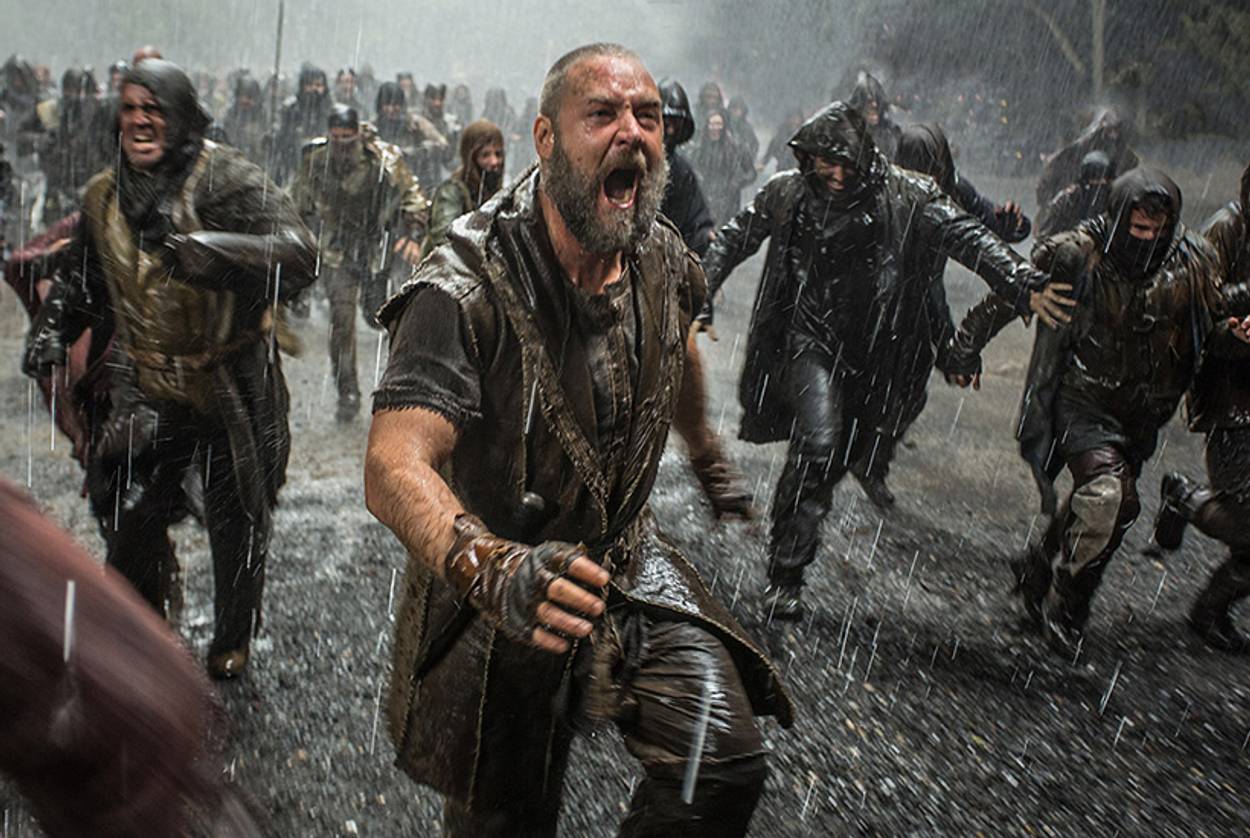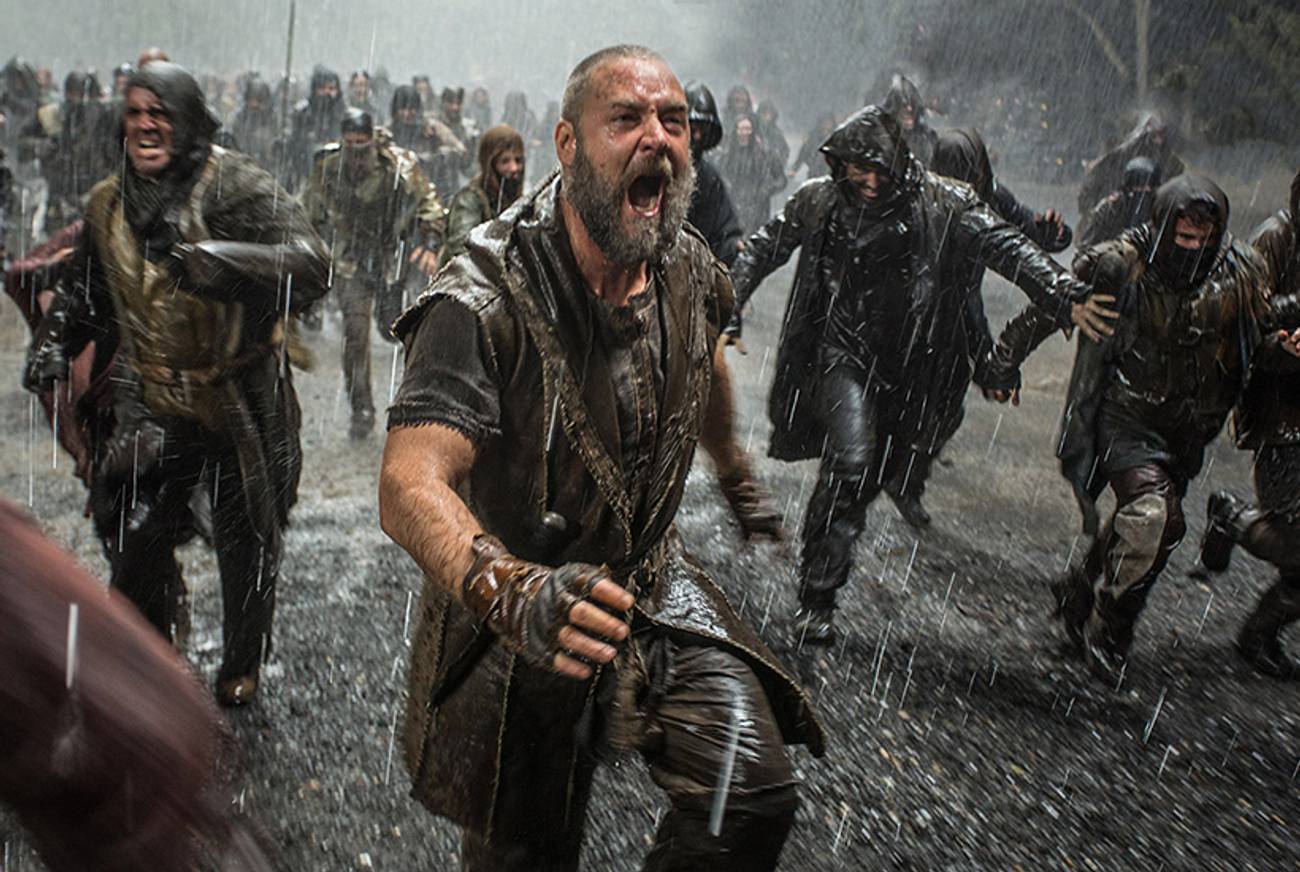Darren Aronofsky’s ‘Noah’ Is a Hot, Wet, Cinematic Mess
It rains and rains in the most eccentric Old Testament adaptation, and most Jewish biblical blockbuster, ever made




When the cine-archaeologists of the future exhume Paramount’s archives, will they discover a sage executive’s napkin-scrawled formula, “(Titanic) + (The Passion of the Christ – subtitles) = NOAH?”
It’s a thought, although Darren Aronofsky already did his version of The Passion as the martyrdom of Mickey Rourke in The Wrestler, and Noah is something else again. Dark, savage, excessive in its add-ons and murky in its details, Aronofsky’s rip-roaring re-reading and re-scripting of Genesis: 6-10, concocted in collaboration with his regular writing partner Ari Handel, is not a blockbuster for the ages. But it is likely the most eccentric Old Testament adaptation to come out Hollywood since John Huston’s The Bible… In the Beginning, wherein, engaging in an epic sort of pissing contest with himself, the director played both Noah and the Voice of God. With all due respect to Cecil B. DeMille’s Ten Commandments—a movie that might have been made in a Las Vegas showroom—Noah is also the most Jewish biblical blockbuster ever made.
Every civilization is entitled to its own version of the Great Flood and its boat-building Sole Survivor, a myth originating in ancient Mesopotamia and first committed to cuneiform some 4,000 years ago. Scholars believe that the Old Testament account of the Flood was composed during the Babylonian exile and after the destruction of the First Temple and thus reflects the trauma of Judean dissolution. Hollywood’s first cinematic portrayal of the deluge, Noah’s Ark (1928), directed by Michael Curtiz from a script by Darryl F. Zanuck, restaged the Great Flood in the context of the Great War. (Although a commercial success, the movie was itself something of a disaster, with a number of extras seriously injured—some say drowned—during the climactic deluge.) Huston’s version of the Noah story was strictly Theater of the Absurd, with a light overlay of current events; in a later episode of The Bible, Sodom’s demise is represented by a mushroom cloud.
The fears of some devout Christian prognosticators who anticipated a consecration of their hero as an “environmentalist wacko” are realized in some part by Aronofsky’s Noah; the movie is haunted by the specter of global warming, sternly asserts the hazards of red meat, and, most significantly, presents the spectacle of a literal-minded patriarch run amok. Evidently observant Muslims have problems with Noah as well; presumably because it violates the tenets against graven images, the movie has been banned unseen throughout the Middle East. The Quranic Noah is a scolding in-your-face prophet, who warns sinners of the impending cataclysm and is ridiculed for his troubles: “Each time I call on them to seek your pardon, they thrust their fingers into their ears and draw their cloaks over their heads,” he complains. (Humanity as a collection of cranky 2-year-olds!)
Noah’s introverted Noah is more circumspect in his public persona and less direct in dealing with the creator. Based on a story that has reportedly fascinated the Brooklyn-born, Harvard-educated filmmaker since seventh grade (was his haftorah Isaiah: 54?), Noah elaborates on the four chapters that the Book of Genesis devotes to the world-destroying deluge and the world-saving ark in a manner that suggests familiarity with ancient Jewish texts as well as modern Marvel comics and Freudian-inflected pop psychology; the cataclysm designed to end life on the planet is rivaled by the storm inside the mind of his eponymous super-hero, played for maximum gruffness by Russell Crowe.
As in the Bible, Cain’s depraved descendants have sullied God’s creation. Noah, a sort of two-fisted Buddhist for whom all life is sacred (in the movie’s first scene he scolds his son for picking a flower), is the last righteous man on earth, except for his grandfather, Methuselah (a Yoda-like Anthony Hopkins teetering on the brink of Alzheimer’s). Noah gets a dream-warning that life on earth is about to be extinguished. Accordingly, he prepares his long-suffering wife Naameh (Jennifer Connelly, who wears a similarly furrowed brow opposite Crowe in A Beautiful Mind) and their three sons Shem, Ham, and Japheth to be the only humans to survive God’s final solution—along with the adopted orphan girl Ila (Emma Watson), who was invented by the filmmakers.
Noah modulates the all-out goofiness of Aronofsky’s ballet body-horror opus Black Swan as well as the ponderous pulp mysticism of The Fountain (a movie which, to plagiarize myself, seems like it was written by Madonna’s kabbalah teacher after a week spent pondering Jodoworsky’s El Topo and dancing to the Incredible String Band), but that scarcely makes for a conventional Sunday-school lesson, or rigorous film-making. The film oscillates between glitzy existential horror and somber showbiz spectacle. Shot largely on location in Iceland—land of lichen, stones, and geysers—Aronofsky’s epic more closely resembles an obscure Viking saga than a mythic tale from the Fertile Crescent: Nordic gloom trumps Middle Eastern mishegas. For all the sturm und drang, the silence of God is deafening.
***
So, why build an ark? Baffled by his uneasy dreams, Noah seeks out Methuselah for guidance; the old man serves his grandson a drought of hallucinogenic tea, enabling him to receive God’s precise instructions for constructing a gigantic floating stockade. The project attracts the attention of the evil Tubal-cain (Ray Winston), a carnivorous killer who is the King of the Cain-ites. According to some traditions, this minor biblical figure was Noah’s half-brother—a family drama that would have upped the psychological ante, but maybe a fillip that Aronofsky and Handel deemed too Star Wars to use.
To protect himself and help construct the ark, Noah manages to enlist the irascible fallen angels known as The Watchers. These six-armed, 16-foot-high rock creatures, the leader of whom is voiced by Nick Nolte, are Aronofsky’s most inspired digital creations, part Incredible Hulk, part Transformer, whose scriptural source is the apocryphal “Book of Enoch”—one of the oldest sources of esoteric doctrine, known to students of Jewish mysticism but canonical only for Ethiopian Jews and the Ethiopian Orthodox Tewahedo Church.
By comparison to the rock ’n’ roll Watchers, the parade of computer-generated animals wending their way to the ark is a bit underwhelming, although the tension ratchets up once they are aboard and the hard rain begins to fall. Naameh has been arguing that the boys will need wives if they are to repopulate the earth but Noah is curiously indifferent to her logic. Indeed, even as Tubal-cain begins an all-out assault on the ark, Noah refuses to save the Lara Croft type that his son Ham has picked up in what seems to be a mass grave.
This unexpected and unmistakably pathological act of meanness is subsumed by a quick cut to a God’s eye view of the roiling planet. Geysers lift the ark aloft, as Noah and family crouch in their dark and smelly sanctuary, listening to the screams of the dying, vainly clinging to the rocks. (Like astronauts on an interplanetary trip, the animals have been put in suspended animation.) Unexpectedly, Aronofsky picks this moment to revisit the first few chapters of Genesis, scanning through the Creation and Garden of Eden. It’s far more entertainingly lurid than the invocation of Genesis that opened The Fountain, let alone the cosmic prehistoric inserts in Terrence Malick’s Tree of Life.
As humanity drowns, the history of earth flashes before our eyes. Noah gets crazier and so does Noah. There are rabbinical commentaries that maintain that the ark was a place of enforced chastity. Noah forbade all sexual activity as inappropriate to the awesome occasion of the world destruction. (It was Ham’s violation of this edict that, according to some, resulted in the punishment of his descendants being turned black.) Aronofsky’s Noah has an even more fanatical motive. Fixated on the notion that, once the animals are saved, “mankind must end,” he wants to do away with human procreation altogether and forever—and thus freaks out when confronted with an unexpected pregnancy.
Here we have Noah’s key theological innovation. For some Christian fundamentalists, Noah prefigures Jesus Christ as a savior who dies and is resurrected. (In this sense, the Flood can be seen as an extreme form of baptism in which the world’s sins are washed away.) It’s worth noting that Noahides, meaning children of Noah, is a Talmudic synonym for gentile. Aronofsky’s Noah is something else. He is recognizably Hollywood, with something of the hardness John Wayne displayed in The Searchers toward his Commanche-defiled niece and more than a bit of James Mason’s cortisone-induced mania in Bigger Than Life: “God spared Isaac but GOD WAS WRONG!!!” But he is also scarily Old Testament. The hero of Noah prefigures Abraham in that, however guilt-racked, he is prepared to slaughter an innocent child to demonstrate his fealty to God. Impossibly stubborn, his neurosis fueled by sexual competition, this Noah is not a savior but an all-too-human punitive patriarch.
It’s hardly a spoiler to note that the story of Noah and the ark has an a priori happy ending—to the relief, I’m sure, of Aronofsky’s anxious producers. Yet there is hint that, like Moses, Noah’s Noah might lead the way to, but will not be permitted to enter, the Promised Land. Drawing on the postdiluvian activities ascribed to Noah in the Book of Genesis, Aronofsky has a brief sequence of him, lying alone in a drunken stupor on the shore of the new Icelandic paradise.
Rainbow reconciliation is not to be denied. But I wonder if this isn’t how Aronofsky would have wanted to take leave of Noah—his mission accomplished, the tragic hero lying hammered on the beach.
***
To read more of J. Hoberman’s National Magazine Award-nominated film criticism, click here.
J. Hoberman, the former longtime Village Voice film critic, is a monthly film columnist for Tablet Magazine. He is the author, co-author or editor of 12 books, including Bridge of Light: Yiddish Film Between Two Worlds and, with Jeffrey Shandler, Entertaining America: Jews, Movies, and Broadcasting.
J. Hoberman was the longtime Village Voice film critic. He is the author, co-author, or editor of 12 books, including Bridge of Light: Yiddish Film Between Two Worlds and, with Jeffrey Shandler, Entertaining America: Jews, Movies, and Broadcasting.